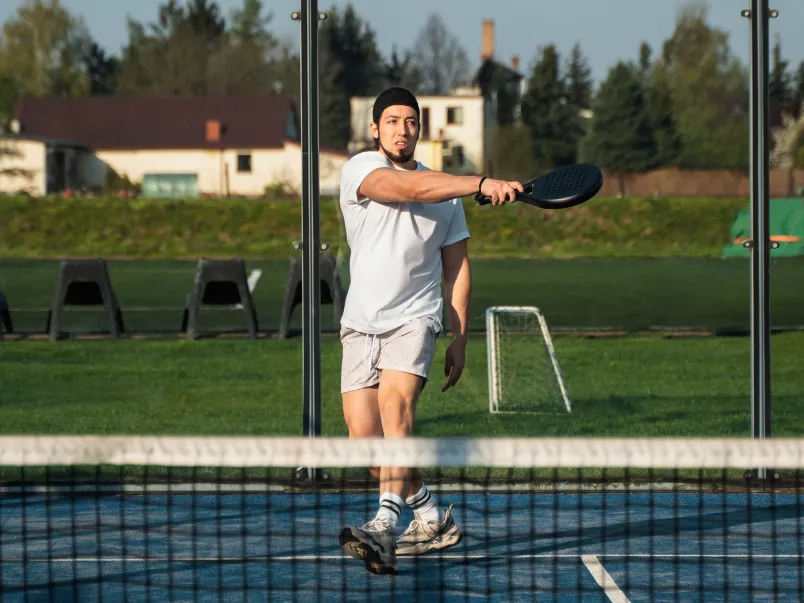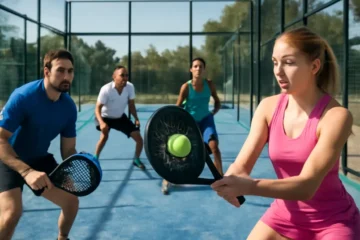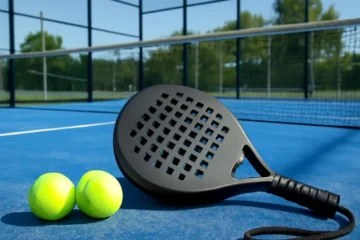The Throne of the Court
In doubles, the team that controls the net controls the match. It’s a simple truth that many players overlook, but it’s the single most decisive factor in winning points and creating pressure. Net play isn’t just about reacting to the opponent’s shots—it’s about putting yourself in the best possible position to dictate the point from the very start. The net is your throne; your goal is to reign from it.
Why is net play so crucial?
- Creates sharper angles for winners: From the net, you can cut off your opponent’s angles, creating the perfect opportunity for a sharp, angled volley or overhead.
- Cuts off the opponent’s options and time: The closer you are to the net, the less time your opponent has to react, making their shots more predictable and easier to intercept.
- Forces errors and weak returns: The pressure of facing two opponents at the net often forces mistakes. Opponents become desperate and resort to high, weak returns or miss their shots altogether.
- It’s a position of offense, not just defense: At the net, you are the aggressor. You can dictate the pace of the point, control the angles, and choose when to strike.
In this guide, we’ll break down the essential mechanics, positioning, communication, and psychology that you need to dominate the net and control the court in doubles.
II. The Foundation: Why Net Play Wins Doubles
Before you can dominate at the net, it’s essential to understand why net play is so powerful in doubles. By being at the net, you’re shrinking the court for your opponents while expanding your own.
The Geometry of the Court
The net position forces your opponents to either hit high, weak shots or aim for risky angles. In either case, you can predict their shots with greater accuracy. When you’re at the net, you’re also in the ideal position to cover the most space, intercepting shots that would otherwise be out of reach. This geometric advantage allows you to control the middle of the court, putting pressure on your opponents from all angles.
Pressure as a Weapon
The psychological advantage of having two players at the net is huge. Your opponents will feel like they have no space to maneuver and that they are constantly under threat of being intercepted. It’s a pressure cooker for them, and when they feel pressure, they are more likely to make mistakes. This is where controlling the net becomes a weapon. Not only do you physically control the space, but you also create mental pressure that leads to errors.
Controlling the “Big Three”
In doubles, there are three shots that dictate the flow of every point: the serve, the return, and the first volley. By dominating the net, you get to control these critical shots.
- The Serve: Serving isn’t just about placing the ball in the service box; it’s about setting up an opportunity to approach the net. A deep, well-placed serve can push your opponent to the back of the court, making it easier to follow up with a volley.
- The Return: As the returning team, your job is to neutralize the server’s position and get yourself into an offensive position. A deep, cross-court return can force the server into a defensive position, giving you an opportunity to move up to the net.
- The First Volley: The first volley is the key to keeping your team on offense. A good first volley sets the tone for the point, keeping your opponents under constant pressure.
When you control these three critical shots, you control the game.
III. The First Rule: Get There! The Art of the Approach
If you want to dominate at the net, the first step is getting there. Whether you’re serving or returning, your goal should always be to move towards the net to establish your position.
The Golden Opportunity: The Serve and Return
The serve and return are your primary opportunities to get to the net. As a server, you shouldn’t treat your serve as an end goal but as a means to an end: getting to the net. Here’s how:
The Serving Team’s Path: “Serve and Volley”
- Mindset: Your serve is a tool to get you into the net. Aim to serve deep, putting pressure on the returner. Don’t stop after the serve—move forward immediately.
- Technique: Aim to serve deep and follow your ball’s trajectory into the service box. Use a split step as you approach, which will allow you to adjust quickly to the return.
The Returning Team’s Path: “Return and Move”
- Goal: Your goal is to neutralize the server with a deep, cross-court return. By doing this, you give yourself a chance to move forward and join your partner at the net.
- Movement: Once you’ve hit a deep return, move quickly toward the net. This will put you in position to intercept any weak replies from the server or their partner.
Key Shot: The Approach Shot
The approach shot is your first opportunity to take control of the net. The best approach shots are:
- Deep down the middle: This causes confusion between the opposing team, as neither player knows who should take the shot.
- Deep cross-court: A safer shot, as it gives you a higher net to clear, making it easier to place with accuracy.
Avoid shots that are too short, weak, or hit at difficult angles that leave you vulnerable at the net.
IV. The Royal Position: Where to Stand and Why
Once you’re at the net, positioning is key to maintaining control.
The “Home Base”: The Ideal Volleying Position
The ideal position for a net player is just a few feet inside the service line. From here, you can cover the middle of the court and have enough time to react to cross-court shots. Positioning yourself in the middle will allow you to cover both the forehand and backhand sides of your opponents.
The “I” Formation & Other Formations
The “I” formation is a popular strategy where one player stands at the net, and the other player stands behind them, either near the baseline or in a more advanced position. This formation can make it easier to poach or force errors from your opponents.
Dynamic Movement: The “Move as One” Principle
When you and your partner move in sync, you’re more effective at controlling the net. As one player moves, the other should follow, making lateral adjustments to maintain coverage and pressure. Communication and trust between partners are crucial for this to work smoothly.
Poaching: The Intentional Intercept
Poaching is when you intentionally intercept a ball that’s aimed at your partner. This is an aggressive tactic that disrupts your opponents’ rhythm and forces them to change their strategy.
Fake Poaching: Using Body Language to Force Errors
Fake poaching is a subtle tactic where you fake as if you’re going to poach the ball, which forces your opponent to hit an error. By moving or feinting, you can throw off their timing, leading them to hit an inaccurate or rushed shot.
The “Switch”: Changing Sides Seamlessly
In doubles, it’s important to switch sides smoothly when necessary. A well-executed switch can throw off your opponents’ rhythm and create new angles for your team.
V. The Weapons of a Net Dominator: Shots and Tactics
When you’re at the net, you need to have the right tools in your arsenal to dominate.
The Volley: Your Primary Weapon
The volley is the primary shot for a net player. To master the volley:
- Punch, Don’t Swing: A compact, firm-wristed punch is more effective than a full swing. This will give you better control over the ball and allow you to place it with precision.
- Angle Volleys: These are essential when you have open court space. Aim for the far corners or open spaces to keep your opponents scrambling.
- Drop Volleys: Surprise your opponents with a well-placed drop volley when they’re expecting a power shot.
The Overhead: The Point-Ender
The overhead is your opportunity to finish the point. Proper positioning and footwork are key to executing a successful overhead:
- Positioning: Stand a few feet behind the service line when preparing to hit the overhead.
- Footwork: Use a “Sky Hook” technique for better reach and placement.
- Decision-making: Determine when to go for power or finesse depending on your opponent’s positioning.
The Most Important Shot in Doubles: The First Volley
The first volley is crucial in keeping your team on offense. Aim deep at your opponent’s feet or at their net player’s feet. This will keep them on the defensive and allow you to maintain control.
VI. The Secret Weapon: Communication and Partnership
Communication is the glue that holds doubles teams together. Whether verbal or non-verbal, effective communication is key to success at the net.
Verbal Cues
Simple verbal cues like “Mine!” “Yours!” “Switch!” and “Leave it!” help ensure that both players are on the same page and reduce confusion during the point.
Non-Verbal Signals
Hand signals behind the back can be used to plan poaching strategies without alerting your opponents. These signals are an effective way to communicate pre-planned moves without verbal cues.
Building Trust
Trusting your partner is vital for aggressive net play. When you trust your partner, you’re more likely to take risks and be aggressive at the net, knowing your partner will back you up.
VII. Common Mistakes and How to Fix Them
Even the best net players make mistakes. Here are some common mistakes and how to fix them:
The “Statue” Syndrome: Standing Still at the Net
Fix: Constant small adjustment steps and a ready split-step will keep you in an active position, ready to react to any shot.
Watching the Ball: Turning Your Head to Watch Your Partner’s Shot
Fix: Keep your eyes on your opponents and their racquets. Trust your partner’s shot and positioning.
Playing Too Tall: Getting Passed Under the Ball
Fix: Get low, bend your knees, and position your racquet under the ball for better control.
Over-hitting: Trying to End the Point with Every Volley
Fix: Focus on placement and depth. Let your opponents make the error.
VIII. Drills to Dominate: Practice Makes Permanent
To dominate at the net, you need to practice regularly. Here are a few drills to help you improve your net game:
The “Two-Up vs. Two-Back” Drill
This drill helps you practice controlling the net under pressure. It forces you to use your volleys and overheads effectively while maintaining aggressive positioning.
Volley-to-Volley Drill
This drill helps improve quick reflexes and compact volleying technique. Focus on hitting clean volleys with minimal swing, aiming for placement.
Poaching Drill
This drill allows one player to practice intercepting shots while the other player feeds cross-court balls. It’s a great way to build anticipation and timing.
IX. Conclusion: Claim Your Throne
To dominate at the net in doubles, you need to understand that net play is about aggression, positioning, and communication. The more aggressive and dynamic you are at the net, the more control you’ll have over the point. Remember, mastering the net isn’t just about winning more points; it’s about playing a more dynamic, intimidating, and ultimately more enjoyable style of doubles.
FAQ: Doubles Tennis Strategy – Dominating the Net
Q1: Why is net play so important in doubles tennis?
A1: Net play is crucial in doubles because it allows you to control the angles, pressure your opponents, and reduce their time to react. Being at the net gives you an offensive position, forcing errors and making it easier to win points through sharper angles and quick volleys.
Q2: How do I get to the net in doubles tennis?
A2: To get to the net, focus on using your serve or return as an opportunity to move forward. For servers, the serve and volley tactic is key, while returners should aim for deep, cross-court returns and follow up by moving towards the net.
Q3: What is the best position at the net in doubles?
A3: The ideal position at the net is just a few feet inside the service line, allowing you to cover both sides of the court effectively. Staying balanced and ready to react is crucial for intercepting shots and making quick volleys.
Q4: How can communication improve my net play in doubles?
A4: Communication is vital in doubles. Verbal cues like “Mine!” or “Yours!” and non-verbal signals (like hand signals for poaching) help synchronize your movements with your partner, ensuring you’re both on the same page and can work together to control the net.
Q5: What common mistakes should I avoid when playing at the net?
A5: Common mistakes include standing still at the net (fix with constant movement and a ready split-step), over-hitting volleys (focus on placement over power), and watching the ball instead of your opponents (keep your eyes on their racquets).
Q6: What drills can help improve my net game in doubles?
A6: Drills like the “Two-Up vs. Two-Back” drill, volley-to-volley practice, and poaching drills can significantly improve your net game. These drills build your reflexes, improve positioning, and help develop aggressive poaching skills.




